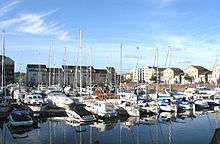Penarth Dock
_Cardiff_Harbour_and_Docks.jpg)
_p290_TAFF_VALE_RAILWAY.jpg)
Penarth Dock was a port and harbour which was located between Penarth Head and the River Ely, at Penarth, Glamorgan, Wales. It opened in 1865 and reached its heyday before World War I, after which followed a slow decline till it closed in the 1960s. The site has since been redeveloped to become Penarth Marina, which now opens into Cardiff Bay.
Early development
Harriet Windsor-Clive, Baroness Windsor, whose Plymouth Estate owned vast areas of Glamorgan, formed the Penarth Harbour Company in 1855 with a view to develop a dock for Penarth. She wanted a facility which could rival the new Cardiff Docks which were being constructed a few miles to the north.[1] She was joined in the venture by several prominent politicians and businessmen and, in 1858, engineer John Hawkshaw designed the dock, curving between the Penarth Head and the River Ely. Work on Penarth Dock began in 1859.[2]
The dock was officially opened on Saturday, 10 June 1865. Though Baroness Windsor and her grandson Robert were intended to perform the ceremony they failed to arrive in time for the high tide. The event was carried out by James Poole, the chairman of the Taff Vale Railway, who were the lessees of the new dock.[3] Penarth Dock covered 26 acres and had a 270 feet long entrance lock.[4]
The Taff Vale Railway took a 999-year lease on Penarth Dock, despite having to fight a legal action against Cardiff's Marquess of Bute as far as the House of Lords to enable them to do so freely. They had initially been given incentives to build their railway to Cardiff Docks rather than Penarth. When they went ahead in 1865 and took a lease on Penarth Dock, the Marquess unsuccessfully tried to levy them on their trade from Penarth.[4]
In operation
.jpg)
Penarth Dock exported 900,000 tons of coal in 1870 and by 1882 was exporting 2 million tons per year.[2] The dock was enlarged in 1884.[4]
In February 1886 Isambard Kingdom Brunel's famous ship, SS Great Britain, in her new role as a coal ship departed from Penarth Docks towards Panama. It was, however, to be her final voyage when, after a fire on board she was diverted to the Falkland Islands[2] and remained there until 1937 as a storage vessel.
Coal exports from Penarth reached a peak in 1913, with 4,660,648 tons exported in that year.[2] Trade declined after the Great War, despite all the coal production of the western South Wales Valleys being sent via Penarth. In 1932 the Earl of Plymouth had to forego his royalty payments to help keep the dock in business, but Penarth Dock finally closed in 1936 after annual exports had dropped to 685,000 tons.[2]
During the Second World War the dock was revived again as a training facility for stevedores and, in 1943, became a base for the United States Navy. But by 1963 Penarth Dock closed for a second time.[2]
Penarth Marina

References
- ↑ "About Baroness Windsor". UK Parliament. Retrieved 29 February 2016.
- 1 2 3 4 5 6 "The Penarth Mysteries: No 2 – The Buried Secrets Of Penarth's Plymouth Park". Penarth Daily News. 4 July 2013. Retrieved 29 February 2016.
- ↑ "150th anniversary of Penarth Dock opening". South Wales Argus. 4 June 2015. Retrieved 29 February 2016.
- 1 2 3 Adam Kirkaldy (1914), British Shipping: Its History, Organisation and Importance, Kegan Paul, Trench, Trübner & Co. Ltd., pp. 557–8